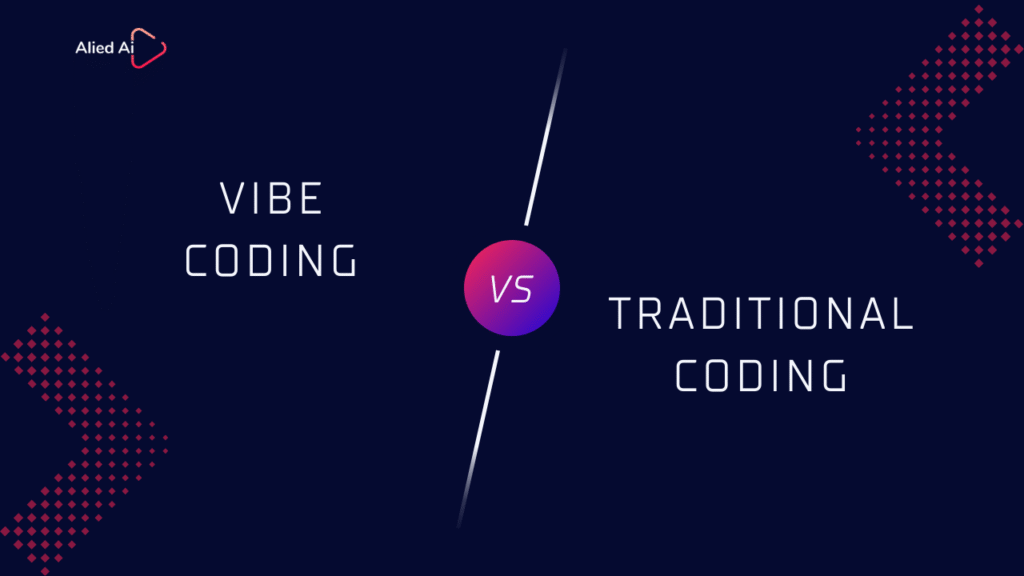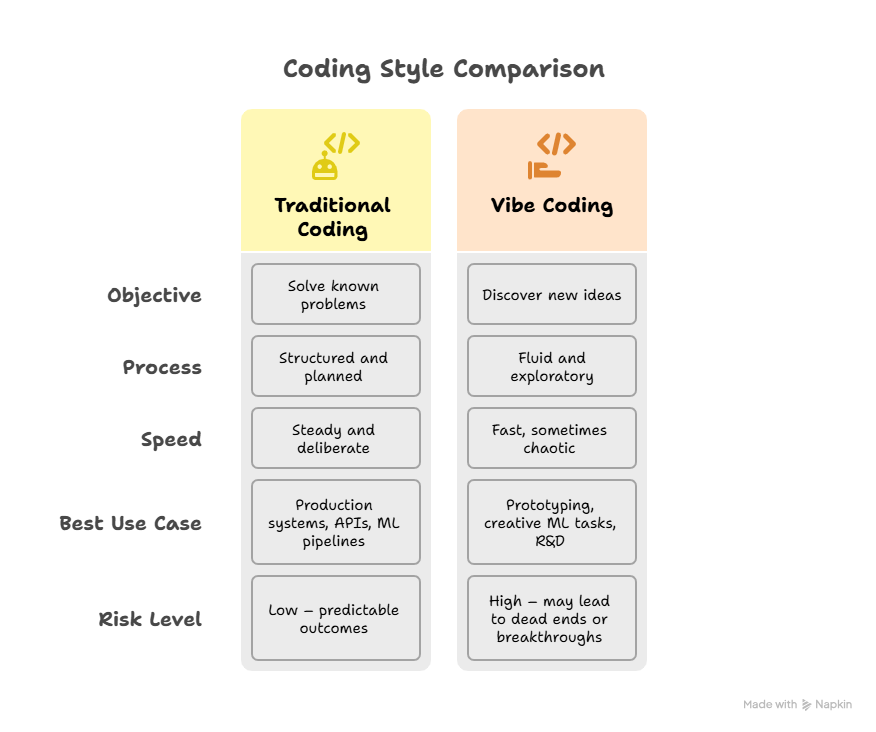In the ever-evolving world of software development, two distinct approaches have emerged: vibe coding and traditional coding. While both aim to produce functional software, their philosophies, processes, and outcomes differ significantly.
While it might sound like a lo-fi playlist or a weekend hackathon buzzword, vibe coding is very real—and when paired with traditional software engineering, it fuels our most creative breakthroughs.
In this post, we’ll explore what vibe coding is, how it differs from traditional coding, and why knowing when to use each is a game-changer in AI and product development.

What is Traditional Coding?
Traditional coding is the structured, systematic approach to writing software that most developers are familiar with.
It relies on:
- Clear specifications
- Agile methodologies
- Version control
- Unit and integration tests
- Documentation
- Code reviews
It’s systematic, predictable, and built for scale. This approach ensures we build robust, maintainable products that meet client expectations and perform under real-world pressure.
Strengths of Traditional Coding:
- Reliability: Produces robust, well-tested code suitable for critical applications like financial systems or medical software.
- Scalability: Well-suited for large-scale projects with multiple developers working together.
- Predictability: Structured processes ensure consistent outcomes and maintainable codebases.
Limitations:
- Time-Intensive: Writing and debugging code can be slow, especially for complex projects.
- Steep Learning Curve: Requires significant time to master programming languages and frameworks.
- Less Flexibility: Strict adherence to syntax and structure can stifle creativity in certain contexts.
Agentic AI — The Goal-Driven Thinker:
What it is:
AI that can reason, plan, and pursue goals, often making decisions based on changing inputs.
Examples:
- An AI optimizing a supply chain
- A robot navigating a warehouse
- A research assistant AI autonomously deciding what information to gather
Key traits:
- Often integrates planning and memory
- Autonomy in pursuing goals
- Can operate without human prompts
What is Vibe Coding?
Vibe coding, a term gaining traction in tech communities, refers to a more intuitive and creative approach to programming. It emphasizes “feeling” the code and leveraging modern tools like AI assistants, low-code platforms, or visual programming environments to create software with less focus on rigid syntax and more on the overall vision or “vibe” of the project.
Key Characteristics of Vibe Coding:
- Intuitive Workflow
- AI and Automation
- Rapid Prototyping
- Visual and Low-Code Tools
- Creative Freedom
Strengths of Vibe Coding:
- Accessibility: Lowers the barrier to entry, allowing non-programmers or beginners to create functional applications.
- Speed: Enables rapid development and iteration, ideal for startups or proof-of-concept projects.
- Creativity-driven: Encourages innovative solutions by focusing on the result rather than the technical minutiae.
Limitations:
- Limited Control: Less suitable for projects requiring fine-tuned optimization or complex backend logic.
- Scalability Challenges: Applications built with vibe coding tools may struggle to scale or integrate with legacy systems.
- Dependency on Tools: Relies heavily on third-party platforms or AI, which may limit customization or introduce dependencies.

The Future: A Hybrid Approach?
While traditional coding and vibe coding may seem like opposites, they’re not mutually exclusive. The future of programming likely lies in a hybrid approach, where developers combine the precision of traditional coding with the speed and creativity of vibe coding. For example, a developer might use vibe coding tools to prototype a web app quickly, and then refine it with traditional coding for scalability and performance.
Here’s how we blend both approaches in our development cycles:
- Inspiration (Vibe Coding): Try weird things. Bend the model. Explore the problem space.
- Validation: Test what worked. Discard what didn’t.
- Producti-onization (Traditional Coding): Package the best ideas into stable, scalable modules.
Final Thoughts
Traditional coding and vibe coding represent two sides of the programming spectrum: one rooted in structure and precision, the other in creativity and speed. In AI, where solutions are often emergent and nonlinear, giving developers space to experiment is just as important as writing testable, scalable code.

